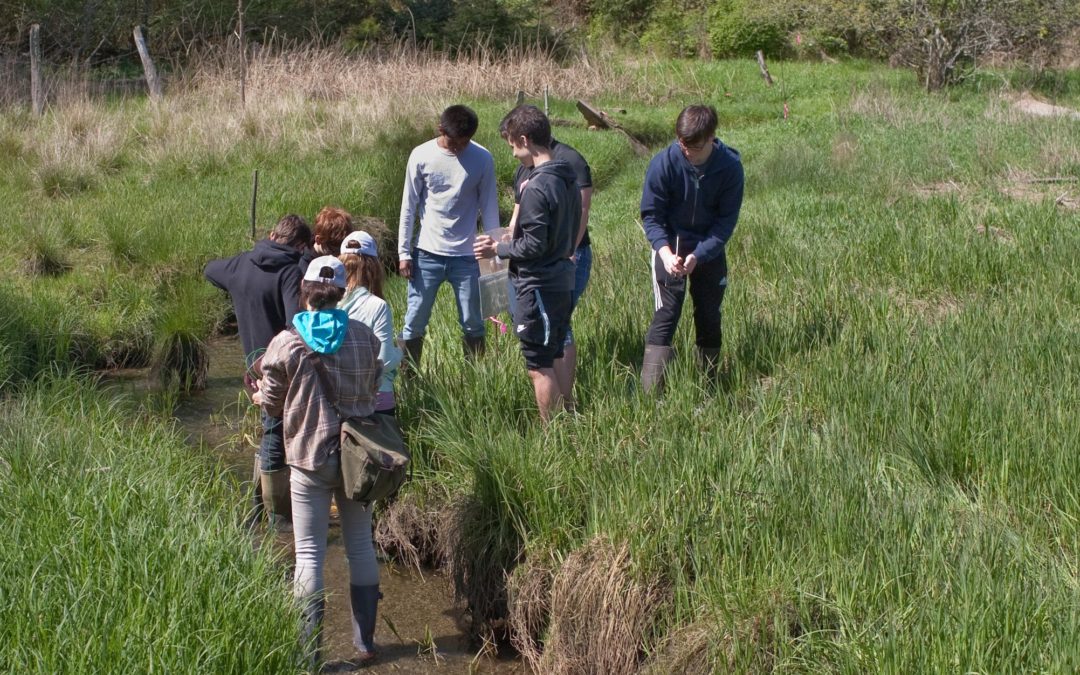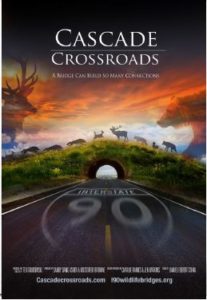By Kathryn True
“This is your job?” a high school biology student asked incredulously, knee-deep in Shinglemill Creek, as she helped Maria Metler catalog juvenile salmonids. The awe and admiration she heard in the question made Metler smile, who as Vashon Nature Center education specialist enjoys introducing students to a side of science they likely haven’t experienced before.
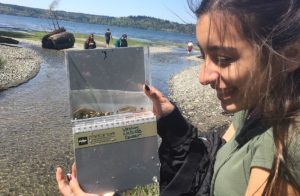
Vashon High School student measures a juvenile coho salmon using a photarium in Shinglemill Creek. Photo by: Bianca Perla
“We’ve helped solidify student curiosity and opened up people’s eyes to the breadth of what science can be,” Metler says, noting that most students like being outside doing hands-on science. “This project shows them that not everything has to be so structured and by the book—this kind of learning experience is very rewarding.”
Over the spring semester, 60 students from three Vashon Island High School biology classes worked with adult scientists and volunteers to collect field data for three citizen science projects run by Vashon Nature Center; two of the projects are also part of regional and national monitoring efforts. The teams will share their findings at ED Talks (the nature center’s research focused spin on TED Talks) on June 4 from 5 to 7:30 pm at Vashon Center for the Arts.
“The project is great to me for several reasons,” says Vashon Island High School biology teacher Jordan Browning. “Students get to do real environmental science fieldwork at a location off-campus, they’re exposed to careers in environmental science, they rigorously analyze real data that they helped collect to answer questions that they pose, and the work that they do makes an actual difference: Various management agencies use the data they collect to make decisions about the Puget Sound region.”
Following their field research, students worked in groups to analyze data and create scientific posters that outline their findings and pose further questions about these projects:
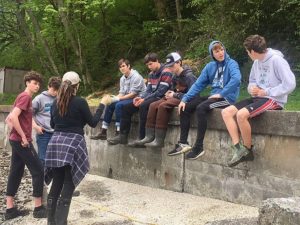
Vashon High School forage fish survey team discusses sampling protocol with VNC volunteer Kat Daniels at Dockton Park. Photo by: Bianca Perla
BeachNET: As part of a broader Puget Sound effort, students sampled a suite of shoreline features to gain insight into how shoreline armoring (bulkheads) affects forage fish, a keystone species in the food web. They completed a sediment survey and beach profile (measurement of the beach angle), recorded terrestrial insects (and collected them to be identified later), cataloged beach wrack (how much of the debris left after high tide is organic, what seaweeds are present and how much of it is human made?), and measured large woody debris.
Sea Star Wasting Syndrome Monitoring Survey: Students teams visited three beaches—Raab’s Lagoon, Maury Island Marine Park and KVI—where they measured a fixed aera of study and looked for sea stars within those boundaries. They recorded all sea stars found, including those with any signs of the syndrome, a widespread viral disease that over the past few years has caused sea-star populations to plummet, from Alaska to California. They also photographed and categorized diseased stars based on the level of wasting they observed.
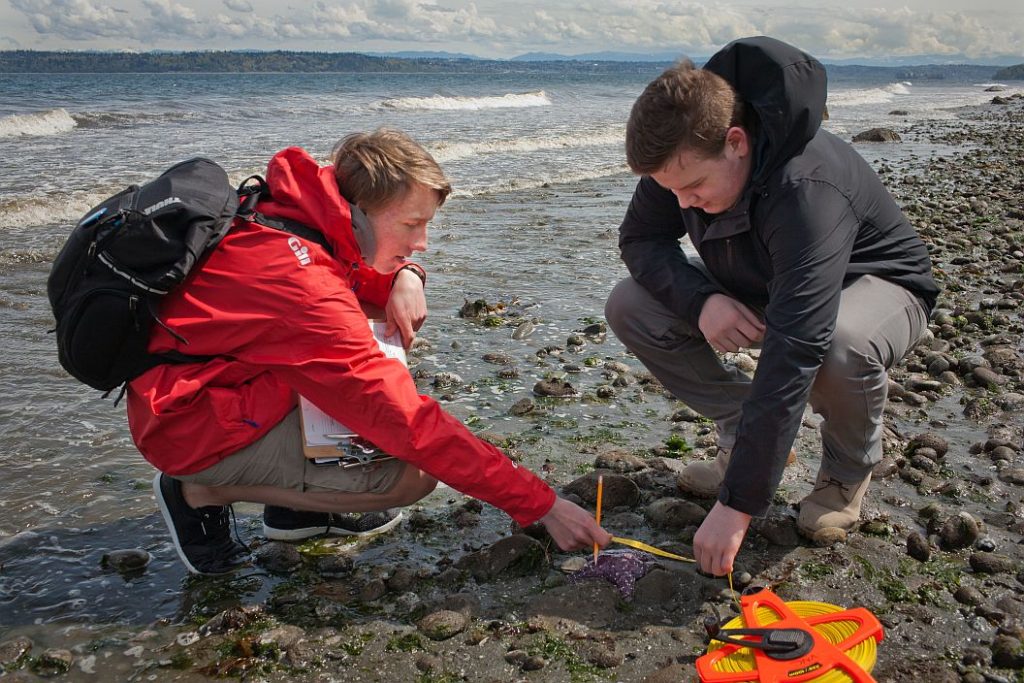
Vashon high school students measure an ochre sea star at KVI beach during a survey for sea star wasting syndrome. Photo by: ©Susie Fitzhugh
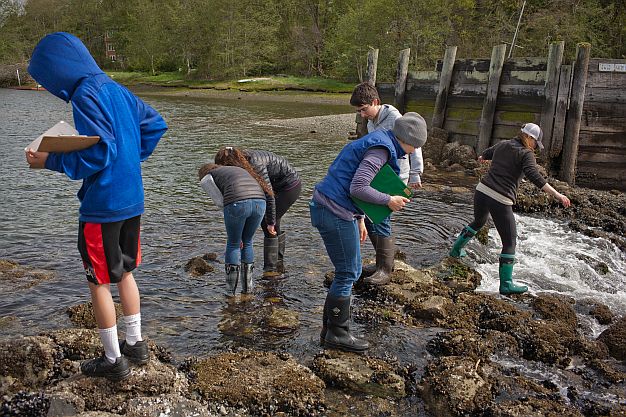
Vashon High school students look for and measure sea stars at Raab’s lagoon alongside VNC scientists Bianca Perla and Heidi Hans Petersen as part of a regional sea star wasting syndrome survey. Photo by: ©Susie Fitzhugh
Juvenile Salmonid Creek Survey: To study redd (salmon nest) success, students collected and worked to identify juvenile salmonids in Ellis, Shinglemill and Judd Creeks. They also took note of chinook or other species that, even if they don’t spawn here, use sheltered creek waters for habitat as juveniles. Recent studies have found young chinook in small streams where these fish do not spawn—evidence that they are using streams as rearing habitats in conjunction with the estuaries they’ve long been known to use.
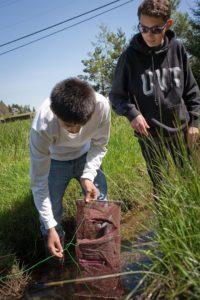
Vashon High School students check traps for juvenile salmon, trout or sculpin at Ellis creek as part of a survey to determine fish use of island streams. Photo by: ©Susie Fitzhugh
“It’s important to remember that the skill of observation is not just a science skill, it’s a life skill,” Metler says. “To allow youth to key into a strength that we all have and help them tap powers they have as an individual, not just in science but in life, is pretty powerful. To me, science is a series of questions and it’s important for youth to remember that even adults don’t have answers to all the questions.”
Like Browning, Metler likes how these projects connect student to science on a larger scale.
“This work validates the students’ efforts because teens often don’t feel they are taken seriously,” Metler says. “For them to collect data that is added to databases used on a regional level and even worldwide is empowering and important.”
ED Talks: June 4, 5 to 7:30 p.m., free
Making Room for Nature in a Growing Puget Sound
5 p.m. Informal poster session: Students and professional scientists will present research on the projects outlined above plus island coyote DNA testing, a regional shoreline armoring study, amphibians, and animal presence cataloged through island roadkill and more.
6 p.m. Jen Watkins, biologist with Conservation Northwest, will screen Cascade Crossroads, a 30-minute film about the collaborative restoration of a critical wildlife corridor that improved Washington’s I-90 freeway over the Cascade Mountains.
6:30 p.m. The filmmaker and a scientist panel will lead an audience discussion and provide local context to the theme, Making Room for Nature in a Growing Puget Sound.
Featured photo at top: VNC scientists Maria Metler and Bianca Perla accompany VHS students on a juvenile fish survey in Ellis Creek. Photo Credit: Susie Fitzhugh

